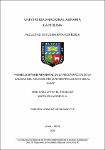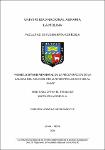Mostrar el registro sencillo del ítem
Modelación bidimensional de la recuperación de la calidad del agua del Río Lurín entre los km 9+300 al 15+100
| dc.contributor.advisor | Ramos Fernández, Lía | |
| dc.contributor.author | Mori Sánchez, Omayra Luzmila | |
| dc.date.accessioned | 2022-02-24T17:19:37Z | |
| dc.date.available | 2022-02-24T17:19:37Z | |
| dc.date.issued | 2021 | |
| dc.identifier.uri | https://hdl.handle.net/20.500.12996/5248 | |
| dc.description | Universidad Nacional Agraria La Molina. Facultad de Ingeniería Agrícola. Departamento Académico de Recursos Hídricos | es_PE |
| dc.description.abstract | El río Lurín es una fuente de agua para la ciudad de Lima; sin embargo, el vertimiento de aguas residuales domésticas, la formación de botaderos, además de los largos periodos de sequía, producen el deterioro del recurso hídrico; por ello, en este estudio se monitoreó el OD, DBO, E.Coli, T, CE, SST, U y h en 8 puntos en el río, 4 en efluentes de PTARs y uno en el retorno de canal de riego la Capilla, haciendo un total de 13 puntos de monitoreo, recorriendo 20km del río, con 9 captaciones de comisiones de regantes distribuidas a lo largo del tramo. Esta información se empleó para calibrar los parámetros de kdbo, kaire, kdos, VsDBO y kdec, en el modelo numérico bidimensional Iber, obteniéndose valores de 0,55 d-1, [4,84 d-1-80,65 d-1], 10 gO2 m-2d-1, 0 m d-1 y [1,49 d-1- 15,42 d-1], respectivamente, con eficiencia de “muy buena” a “satisfactoria” con valores de E: 0,813, 0,959, 0,944 y 0,518 para OD, DBO5, E.Coli y T, respectivamente. El tiempo computacional en cada simulación fue de 3 días, considerándose una discretización con una malla con resolución de 3, 5 y 7 m en el cauce, riberas y llanuras, respectivamente. La mayor contaminación se concentra en el tramo bajo, a la altura del km 5+400, hasta el puente Panamericana, siendo julio el mes más crítico; por ello, se propone un escenario a fin de recuperar el río, que consiste en la implementación de la PTAR Pachacámac y la optimización de la PTAR San Bartolo con caudales de descarga de 0.373 m3s-1 y 0.980 m3s-1, respectivamente, con concentraciones de 4 mg l-1, 15 mg l-1 y 1000 NMP/100ml para la T, OD, DBO5 y E.Coli, respectivamente,lo que permitirá que el río cumpla con los ECA respectivos | es_PE |
| dc.description.abstract | The Lurín River is a source of water for the city of Lima; however, the dumping of domestic wastewater, the formation of dumps, in addition to long periods of drought, cause the deterioration of the water resource; therefore, in this study the DO, BOD, E.Coli, T, CE, SST, U and h were monitored in 8 points in the river, 4 in effluents from WWTPs and one in the return of the irrigation canal La Capilla, making a total of 13 monitoring points, covering 20km of the river, with 9 catchments from irrigation commissions distributed along the stretch. This information was used to calibrate the parameters of kdbo, kaire, kdos, VsDBO and kdec, in the two-dimensional numerical model Iber, obtaining values of 0,55 d-1, [4,84 d-1-80,65 d-1], 10 gO2 m-2d-1, 0 m d-1 y [1,49 d-1- 15,42 d-1], respectively, with efficiencies from "very good" to "satisfactory" with E values: 0.813, 0.959, 0.944 and 0.518 for OD, DBO5, E.Coli and T, respectively. The computational time in each simulation was 3 days, considering a discretization with a mesh with a resolution of 3, 5 and 7 m in the riverbed, riverbanks and plains, respectively. The greatest contamination is concentrated in the lower section, at the height of km 5 + 400, up to the Pan-American bridge, with July being the most critical month; therefore, a scenario is proposed in order to recover the river, which consists of the implementation of the PTAR Pachacámac and the optimization of the PTAR San Bartolo with discharge flows of 0.373 m3s-1 and 0.980 m3s-1, respectively, with concentrations of 4 mg l-1, 15 mg l-1 y 1000 NMP/100ml of the T, OD, DBO5 y E.Coli, respectively, which will allow the river to comply with the respective ECA | en_US |
| dc.format | application/pdf | en_US |
| dc.language.iso | spa | es_PE |
| dc.publisher | Universidad Nacional Agraria La Molina | es_PE |
| dc.rights | info:eu-repo/semantics/embargoedAccess | en_US |
| dc.rights.uri | https://creativecommons.org/licenses/by-nc/4.0/ | * |
| dc.subject | Cursos de agua | es_PE |
| dc.subject | Cuencas hidrográficas | es_PE |
| dc.subject | Modelos matemáticos | es_PE |
| dc.subject | Inundación | es_PE |
| dc.subject | Ingeniería hidráulica | es_PE |
| dc.subject | Evaluación | es_PE |
| dc.subject | Perú | es_PE |
| dc.subject | Modelamiento hidráulico bidimensional | es_PE |
| dc.subject | Reutilización de aguas | es_PE |
| dc.subject | Tratamiento de aguas residuales | es_PE |
| dc.subject | Río Lurín | es_PE |
| dc.title | Modelación bidimensional de la recuperación de la calidad del agua del Río Lurín entre los km 9+300 al 15+100 | es_PE |
| dc.type | info:eu-repo/semantics/bachelorThesis | en_US |
| thesis.degree.discipline | Ingeniería Agrícola | es_PE |
| thesis.degree.grantor | Universidad Nacional Agraria La Molina. Facultad de Ingeniería Agrícola | es_PE |
| thesis.degree.name | Ingeniero Agrícola | es_PE |
| dc.subject.ocde | https://purl.org/pe-repo/ocde/ford#1.05.08 | es_PE |
| renati.author.dni | 73003063 | es_PE |
| dc.publisher.country | PE | es_PE |
| dc.type.version | info:eu-repo/semantics/publishedVersion | en_US |
| dc.date.embargoEnd | 2024-02-04 | |
| dc.date.embargoEnd | 2024-02-04 | |
| renati.advisor.orcid | https://orcid.org/0000-0003-3946-7188 | es_PE |
| renati.advisor.dni | 07462206 | es_PE |
| renati.type | https://purl.org/pe-repo/renati/type#tesis | es_PE |
| renati.level | https://purl.org/pe-repo/renati/level#tituloProfesional | es_PE |
| renati.discipline | 811096 | es_PE |
| renati.juror | Chávarri Velarde, Eduardo Abraham | |
| renati.juror | Fano Miranda, Gonzalo Ramcés | |
| renati.juror | Apaclla Nalvarte, Ricardo |
Ficheros en el ítem
Este ítem aparece en la(s) siguiente(s) colección(ones)
-
IAG-RH Tesis [310]




